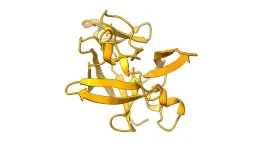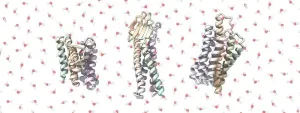(Press-News.org) As a neurodegenerative disease characterized by childhood onset dementia, Sanfilippo syndrome causes immense suffering in many ways, including pain, loss of speech, extreme agitation, and distress, gastrointestinal symptoms, and profound sleep disturbance. With no approved treatment, clinical specialists have had few options to help alleviate this suffering until now. A groundbreaking clinical trial collaboration between study lead and principal investigator Lynda Polgreen, MD, MS, Investigator at The Lundquist Institute for Biomedical Innovation at Harbor-UCLA (TLI) and Associate Professor of Pediatrics at the David Geffen School of Medicine at UCLA and Cure Sanfilippo Foundation’s Chief Science Officer and study co-investigator, Cara O’Neill, MD, FAAP, used an innovative approach to treat this disease by targeting neuroinflammation, as it is thought to be a key contributor to disease symptoms.
Dr. Polgreen’s team used anakinra, a recombinant interleukin-1 receptor antagonist, in children and young adults with moderate to advanced stages of the condition, meaning they were all experiencing debilitating, life-limiting symptoms at the time of study enrollment. While ongoing clinical trials are searching for a cure for Sanfilippo syndrome, such trials are restricted to specific disease subtypes and include only the youngest of children exhibiting very few symptoms because the disease is considered irreversible. This has left more than 99% of the Sanfilippo population without any opportunity to receive focused treatment. However, the research team’s revolutionary clinical study was designed to improve the representation of this long-excluded segment of the Sanfilippo community by treating individuals who have already been significantly impacted by their disease.
Sanfilippo syndrome, also known as mucopolysaccharidosis type III (MPS III), is considered an orphan disease, which classifies it for special considerations in drug development and policy. It is a rare genetic disorder in which the body is unable to break down the complex molecule heparan sulfate. Accumulation of heparan sulfate in cells then triggers several biological consequences, including inflammation, ultimately leading to progressive dementia and body-wide disease. Anakinra works by inhibiting interleukin-1 (IL-1), a key mediator of the inflammatory response. By blocking the activity of IL-1, anakinra reduces harmful inflammation in the body and brain. For the first time, this study provides evidence that anakinra can positively impact meaningful disease symptoms in patients with Sanfilippo syndrome.
In the phase 1/2 trial, researchers evaluated anakinra's safety, tolerability, and effects on neurobehavioral, functional, and quality-of-life outcomes in patients with several subtypes of Sanfilippo syndrome. Results showed anakinra was safe and associated with significant improvements in multiple symptom domains. By week 36 of treatment, 94% of participants showed improvement in at least one domain. Most adverse events were mild, with injection site reactions being the most common. Crucially, no serious adverse events related to the use of anakinra were reported, underscoring its safety profile.
Dr. Lynda Polgreen, the study's principal investigator, expressed optimism about the results, "The changes we observed in our patients represent significant improvements in the day-to-day lives of individuals with Sanfilippo syndrome and their families. This trial highlights the potential of anakinra as an adjunctive treatment option and underscores the broader importance of targeting downstream effects, such as inflammation, in lysosomal diseases."
“Together with Dr. Polgreen, we recognized an opportunity to translate existing preclinical proof of concept research into a drug repurposing trial which had the potential to benefit children imminently. Cure Sanfilippo Foundation is proud to have partnered with and supported this highly skilled and compassionate research team led by Dr. Polgreen (TLI), including the expertise of Dr. Eisengart (University of Minnesota) and Dr. Chen (TLI), to address the urgent needs of the patient community. We are also grateful to have collaborated with Sobi, who generously provided study drug. This close collaboration and integration of patient/caregiver perspectives have facilitated using novel outcome instruments and patient-centered study design that will inform future drug development in this ultra-rare disease,” reflected Dr. O’Neill.
“Funding provided by Cure Sanfilippo Foundation to support all clinical trial activities and patient travel was made possible by generous donors and families who support the Foundation’s mission; creating new opportunities to transform lives. We look forward to partnering with The Lundquist Institute to advance additional clinical programs,” said Cure Sanfilippo Foundation President and Co-Founder Glenn O’Neill.
“This study has made immediate strides toward addressing the need to help all people touched by this condition, regardless of their level of disability,” noted Julie Eisengart, Ph.D., Associate Professor of Pediatrics and Director of the Neurodevelopmental Program in Rare Disease at the University of Minnesota Medical School. “This trial shows promise for improving the lived experience of not only the people diagnosed with Sanfilippo syndrome, but also their families who face countless disease-related stressors and heartache.”
This study supports the potential of anakinra as a therapeutic option for Sanfilippo syndrome. It opens the door to its application in other MPS and similar neurodegenerative disorders characterized by neuroinflammation. With these encouraging results, further research is vital to explore the full potential of anakinra in changing the trajectory of Sanfilippo syndrome and providing hope to affected families worldwide.
END
Landmark Nature Medicine study reports promising new treatment reduces suffering in Sanfilippo syndrome
The study found that the blood-brain barrier crossing anti-inflammatory anakinra was safe and associated with improved neurobehavioral and functional outcomes in Sanfilippo syndrome
2024-06-21
ELSE PRESS RELEASES FROM THIS DATE:
Membrane protein analogues could accelerate drug discovery
2024-06-21
Many drug and antibody discovery pathways focus on intricately folded cell membrane proteins: when molecules of a drug candidate bind to these proteins, like a key going into a lock, they trigger chemical cascades that alter cellular behavior. But because these proteins are embedded in the lipid-containing outer layer of cells, they are tricky to access and insoluble in water-based solutions (hydrophobic), making them difficult to study.
"We wanted to get these proteins out of the cell membrane, so we redesigned them as hyperstable, soluble analogues, which look like membrane proteins but are much ...
Berkeley Lab researchers advance AI-driven plant root analysis
2024-06-21
In a world striving for sustainability, understanding the hidden half of a living plant – the roots – is crucial. Roots are not just an anchor; they are a dynamic interface between the plant and soil, critical for water uptake, nutrient absorption, and, ultimately, the survival of the plant. In an investigation to boost agricultural yields and develop crops resilient to climate change, scientists from Lawrence Berkeley National Laboratory’s (Berkeley Lab’s) Applied Mathematics and Computational Research (AMCR) and Environmental Genomics and Systems Biology (EGSB) Divisions have made a significant leap. Their latest innovation, RhizoNet, harnesses the power ...
Cleveland Clinic study shows weight loss surgery cuts risk of heart complications and death in patients with obstructive sleep apnea and obesity
2024-06-21
Press release under embargo:
Cleveland Clinic Study Shows Weight Loss Surgery Cuts Risk of Heart Complications and Death in Patients with Obstructive Sleep Apnea and Obesity
First-of-its-kind MOSAIC study shows weight-loss surgery is associated with a 42% reduction in risk of heart complications and 37% reduction in risk of death in patients with obstructive sleep apnea
Under embargo until Friday, June 21, 2024, 9:00 AM ET, CLEVELAND: A Cleveland Clinic study shows that bariatric surgery performed in patients with obesity and moderate to severe obstructive sleep apnea is associated with a significantly lower risk of ...
SQUID pries open AI black box
2024-06-21
Artificial intelligence continues to squirm its way into many aspects of our lives. But what about biology, the study of life itself? AI can sift through hundreds of thousands of genome data points to identify potential new therapeutic targets. While these genomic insights may appear helpful, scientists aren’t sure how today’s AI models come to their conclusions in the first place. Now, a new system named SQUID arrives on the scene armed to pry open AI’s black box of murky internal logic.
SQUID, ...
Resiliency shaped by activity in the gut microbiome and brain
2024-06-21
A new UCLA Health study has found that resilient people exhibit neural activity in the brain regions associated with improved cognition and regulating of emotions, and were more mindful and better at describing their feelings. The same group also exhibited gut microbiome activity linked to a healthy gut, with reduced inflammation and gut barrier.
For the study, rather than examine microbiome activity and composition linked to disease conditions-- like anxiety and depression -- the researchers wanted to flip the script and study the gut microbiome and brain in healthy, resilient people who effectively cope with different types of stress, including discrimination ...
Inspired by nature: synthetic nightshade molecule effective against leukemia cells
2024-06-21
Nightshade plants produce a diverse array of compounds with therapeutic potential. Researchers at CeMM have now identified an artificial variant inspired by the Withanolides group that acts highly specifically against leukemia cells. Using state-of-the-art chemical and genetic high-throughput analyses, the team led by Georg Winter not only confirmed its effectiveness but also elucidated its mechanism of action: the molecule disrupts the cholesterol metabolism of tumor cells. The study's findings ...
Promise green hydrogen may not always be fulfilled
2024-06-21
Green hydrogen often, but certainly not always, leads to CO2 gains. This claim is based on research published in Nature Energy by Kiane de Kleijne from Radboud University and Eindhoven University of Technology. “If you calculate the entire life cycle of green hydrogen production and transport, CO2 gains may be disappointing. However, if green hydrogen is produced from very clean electricity and locally, it can really help reduce emissions.”
It is thought that green hydrogen can make ...
Unifying behavioral analysis through animal foundation models
2024-06-21
Although there is the saying, “straight from the horse’s mouth”, it's impossible to get a horse to tell you if it's in pain or experiencing joy. Yet, its body will express the answer in its movements. To a trained eye, pain will manifest as a change in gait, or in the case of joy, the facial expressions of the animal could change. But what if we can automate this with AI? And what about AI models for cows, dogs, cats, or even mice? Automating animal behavior not only removes observer bias, but it helps humans more efficiently get to the right answer.
Today ...
Up to 30 percent more time: Climate change makes it harder for women to collect water
2024-06-21
Climate change could increase the amount of time women spend collecting water by up to 30 percent globally by 2050, according to a new study published in Nature Climate Change. In regions of South America and Southeast Asia, the time spent collecting water could double due to higher temperatures and less rainfall. A team of scientists from the Potsdam Institute for Climate Impact Research (PIK) estimates the large welfare losses that could result from climate impacts and highlights how women are particularly vulnerable to changing future climate conditions. Worldwide, two billion people currently lack access to safe drinking water. The ...
Heart failure in space: scientists calculate potential health threats facing future space tourists in microgravity
2024-06-21
[The following is a guest editorial written by Dr Lex van Loon, an assistant professor at the Australian National University and the University of Twente in the Netherlands. He is co-author of a new Frontiers in Physiology article.]
Space exploration has always captivated our imagination, offering the promise of discovering new worlds and pushing the boundaries of human capability. As commercial space travel becomes more accessible, individuals with various underlying health conditions—including heart failure—may soon be among those venturing beyond Earth’s atmosphere. This raises critical questions about the impact of space travel ...
LAST 30 PRESS RELEASES:
Decoupling the HOR enhancement on PtRu: Dynamically matching interfacial water to reaction coordinates
Sulfur isn’t poisonous when it synergistically acts with phosphine in olefins hydroformylation
URI researchers uncover molecular mechanisms behind speciation in corals
Chitin based carbon aerogel offers a cleaner way to store thermal energy
Tracing hidden sources of nitrate pollution in rapidly changing rural urban landscapes
Viruses on plastic pollution may quietly accelerate the spread of antibiotic resistance
Three UH Rainbow Babies & Children’s faculty elected to prestigious American Pediatric Society
Tunnel resilience models unveiled to aid post-earthquake recovery
Satellite communication systems: the future of 5G/6G connectivity
Space computing power networks: a new frontier for satellite technologies
Experiments advance potential of protein that makes hydrogen sulfide as a therapeutic target for Alzheimer’s disease
Examining private equity’s role in fertility care
Current Molecular Pharmacology achieves a landmark: real-time CiteScore advances to 7.2
Skeletal muscle epigenetic clocks developed using postmortem tissue from an Asian population
Estimating unemployment rates with social media data
Climate policies can backfire by eroding “green” values, study finds
Too much screen time too soon? A*STAR study links infant screen exposure to brain changes and teen anxiety
Global psychiatry mourns Professor Dan Stein, visionary who transformed mental health science across Africa and beyond
KIST develops eco-friendly palladium recovery technology to safeguard resource security
Statins significantly reduce mortality risk for adults with diabetes, regardless of cardiovascular risk
Brain immune cells may drive more damage in females than males with Alzheimer’s
Evidence-based recommendations empower clinicians to manage epilepsy in pregnancy
Fungus turns bark beetles’ defenses against them
There are new antivirals being tested for herpesviruses. Scientists now know how they work
CDI scientist, colleagues author review of global burden of fungus Candida auris
How does stroke influence speech comprehension?
B cells transiently unlock their plasticity, risking lymphoma development
Advanced AI dodel predicts spoken language outcomes in deaf children after cochlear implants
Multimodal imaging-based cerebral blood flow prediction model development in simulated microgravity
Accelerated streaming subgraph matching framework is faster, more robust, and scalable
[Press-News.org] Landmark Nature Medicine study reports promising new treatment reduces suffering in Sanfilippo syndromeThe study found that the blood-brain barrier crossing anti-inflammatory anakinra was safe and associated with improved neurobehavioral and functional outcomes in Sanfilippo syndrome






